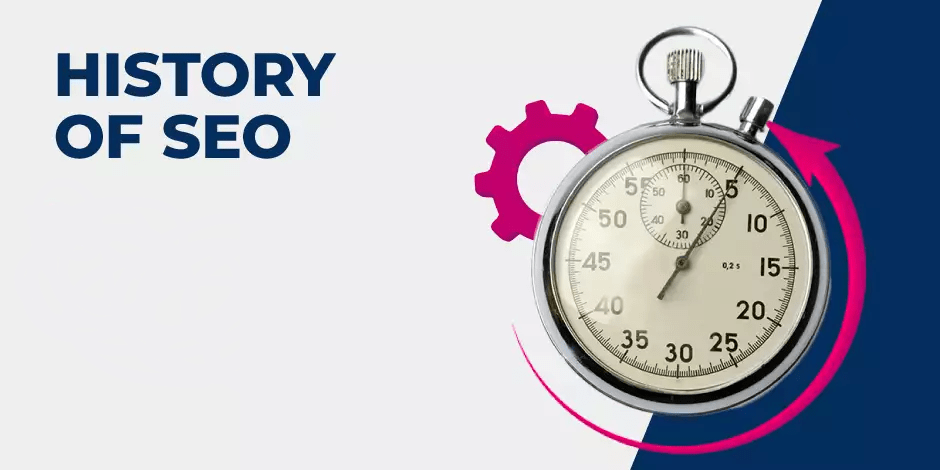Tracing the history of search & SEO is a bit like trying to trace the history of the handshake. We know it’s widely used and plays a crucial role in business, but we don’t often think about where it began – our focus is more on how we apply it in our daily lives.
Unlike the handshake, however, the history of search & SEO is relatively new and constantly evolving. It seems fitting to call it a millennial, as its origins are believed to date back somewhere around 1991.
Despite its short existence, SEO has grown and adapted rapidly – especially when you consider how many changes Google’s algorithm has undergone in that time.

However, the digital age has transformed the way people access information. One of the most important drivers of this transformation has been the search engine, which is now a ubiquitous tool that helps users find what they need in seconds.
Coupled with the development of search engines is the growth of Search engine optimization (SEO), a discipline focused on improving the visibility of websites on search engine results pages (SERPs).
Together, search engines and SEO have shaped the internet landscape and impacted how people connect with information, businesses, and services.
In this article, we’ll explore the development of search engines, the rise of SEO, and the significant milestones that have defined the relationship between the two.
But First, a Look Back at Search Engines
Before diving into the specifics of SEO, it’s important to understand the origins of search engines themselves. In the early 1990s, the internet was a vastly different place—an unstructured collection of websites and data with little to no organization.
Early search engines served as rudimentary directories that helped users navigate the growing web. However, they lacked the sophistication of modern search engines in terms of relevance, ranking, and user experience.
The early versions of search engines like Archie, Veronica, and Jughead were largely focused on file indexing, and they paved the way for more advanced systems that could rank web pages based on content.
Then came the first true web search engine: World Wide Web Wanderer (1993). It was followed by Excite, Yahoo!, AltaVista, and Lycos, which helped shape the way users interacted with search technology in the early web era.
As the number of websites grew exponentially, the need for a better way to find relevant information became clear. This challenge gave rise to both modern search engines and the SEO industry, which sought to capitalize on users’ growing reliance on search results.
A Brief History of Search & SEO
SEO, as a discipline, began as soon as search engines started to evolve beyond simple file directories.
Early search engines, like AltaVista and Yahoo!, ranked pages based on content and the frequency of keywords, creating opportunities for early SEO practitioners to optimize sites for higher rankings.
However, it wasn’t until the arrival of Google in 1998 that the field of SEO truly began to take shape. Google’s introduction of the PageRank algorithm revolutionized search by focusing on backlinks as a way to determine relevance and authority.
This shift laid the groundwork for modern SEO practices. From the early days of keyword stuffing and basic on-page optimization to the sophisticated, algorithm-driven strategies of today, SEO has gone through several phases of evolution.
Let’s take a deeper look at how the world of search and SEO has changed over the decades.
The ‘90s: The Dawn of SEO
The 1990s were a period of rapid expansion for the internet. With the arrival of commercial websites, businesses quickly realized the potential of being found online.
Search engines like Yahoo!, AltaVista, and Excite relied heavily on keyword matching, and SEO was born as a response to the growing competition for top spots in search results.
Early SEO was relatively simple. Website owners stuffed their pages with keywords, often without regard to content quality or user experience.
Techniques like meta tag optimization and keyword density were prevalent, and there was little to no regulation against practices that might now be considered spammy.
However, by the end of the decade, Google’s PageRank algorithm introduced a new approach to search.
By considering the number and quality of links pointing to a webpage, Google emphasized the importance of authoritative content, and SEO practitioners had to adapt to this new reality.
The Early 2000s: The Rise of Algorithm-Based Search
In the early 2000s, search engines were rapidly advancing, and with that came changes in SEO.
Google had become the dominant player in the search engine space by 2000, and its focus on algorithm-based rankings meant that quality content and natural backlinks were increasingly important.
The simplistic tactics of the 1990s—like keyword stuffing—became less effective as Google’s algorithm became more sophisticated.
2000-2002: Shifting Focus on Quality
During this time, Google AdWords (introduced in 2000) transformed the way businesses approached search. SEO now existed alongside paid search advertising, and both were critical components of a business’s online marketing strategy.
Meanwhile, Google Toolbar (released in 2001) allowed users to see a website’s PageRank score, further increasing the focus on acquiring high-quality backlinks and authoritative content.
During these years, SEO began to evolve from a somewhat haphazard discipline into a more structured and strategic practice. Websites were no longer ranked based solely on keyword presence but also on content relevance, link quality, and user experience.
2003-2004: Algorithm Updates and Link Building
The early 2000s also marked the beginning of Google’s continuous improvements to its search algorithm. The introduction of updates like Florida (2003) helped reduce the effectiveness of spammy SEO practices, penalizing websites that relied on keyword stuffing and link farming.
This period also saw the rise of link building as a critical SEO strategy. Businesses began investing in creating more content to attract natural backlinks and improve their authority in the eyes of Google.
2005: A Big Year for SEO
In 2005, SEO hit another critical turning point. Google launched Google Analytics, providing website owners and SEO practitioners with deep insights into website performance, traffic sources, and user behavior.
This data was instrumental in helping businesses refine their SEO strategies and focus on what worked.
At the same time, nofollow links were introduced as a way to combat spammy backlinks. The nofollow tag allowed webmasters to tell search engines not to count certain links toward their PageRank scores, particularly those from untrusted sources.
Additionally, Google Maps was integrated into search results, signaling the beginning of the shift toward local SEO.
2009: SEO Shakeups
By 2009, SEO had grown into a complex and highly competitive field. Google’s increasing sophistication meant that low-quality, spammy tactics were becoming less and less effective. Instead, Google began prioritizing relevant, high-quality content and strong user experiences.
Google’s Caffeine update, introduced in 2009, further enhanced its ability to deliver fresh, relevant results by improving the speed and accuracy of indexing.
This year also marked a significant development in SEO with the growing importance of social media. Search engines started factoring in social signals—such as shares, likes, and tweets—as indicators of content relevance and authority.
2010-Present: The Era of Quality and User Experience
The 2010s marked a significant shift in SEO, with Google making several major algorithm updates designed to improve search results and reduce the impact of low-quality tactics.
2011: The Year of the Panda
In 2011, Google rolled out the Panda update, which targeted websites with thin, low-quality content. The Panda algorithm penalized sites that relied on content farms or duplicated content from other sources.
This update forced businesses to invest in high-quality, original content as a core part of their SEO strategies.
2012: Along Came a Penguin
The following year, Google introduced the Penguin update, which targeted manipulative link-building practices. Websites that used tactics such as buying links or participating in link exchanges were hit hard by this update.
As a result, SEO professionals had to focus more on earning high-quality, natural backlinks and improving site authority organically.
Google Goes Local
Around this time, Google also began to place more emphasis on local search results, especially for businesses serving specific geographic areas.
The introduction of the Pigeon update in 2014 refined the accuracy of local search results, tying them more closely to traditional web ranking signals like content quality and link authority.
For businesses with a local presence, this meant an increased focus on local SEO strategies, including optimizing Google My Business listings, gathering customer reviews, and ensuring consistency in citations across the web.
Then, in 2015…
In 2015, Google made another significant move with the release of the Mobilegeddon update. This update prioritized mobile-friendly websites in search results, reflecting the growing importance of mobile search.
As more users turned to smartphones and tablets to access the web, having a responsive, mobile-optimized site became a crucial factor in SEO.
Additionally, RankBrain, an AI-driven algorithm, was introduced to help Google better understand user intent. This shift toward machine learning marked the beginning of Google’s transition into a more intelligent and user-centric search engine.
What’s Next?
Looking forward, the future of SEO is being shaped by advancements in technology, changes in user behavior, and new search platforms. Here are some trends that are likely to define the future of search and SEO.
To Mobile and Beyond
As of today, mobile search has overtaken desktop search in terms of volume, and this trend is likely to continue. Google has emphasized mobile-friendliness through updates like mobile-first indexing, which prioritizes the mobile version of a website for ranking and indexing purposes.
In the coming years, SEO will need to be even more focused on mobile performance, including page speed, user experience, and navigation on mobile devices.
Going Local
Local SEO is also becoming increasingly important as users search for nearby businesses and services on their smartphones.
Search engines are getting better at delivering hyper-local results, meaning that businesses need to focus on optimizing for local intent and ensuring their online presence is easily discoverable.
Voice search is another factor influencing the future of local SEO. As voice-enabled devices like Google Home and Amazon Echo grow in popularity, users are conducting more local searches through voice commands.
This will impact how businesses structure their SEO strategies, with a focus on conversational keywords and natural language.
Getting Social
Social signals are becoming more influential in determining search rankings. Social media platforms are increasingly integrated into search engines, and content that performs well on Social media is likely to see a boost in organic rankings.
Additionally, social media profiles themselves are often ranked in search results, making it important for businesses to maintain strong, active presences across platforms.
Social platforms like Facebook, Instagram, and YouTube are also turning into search engines in their own right.
Users are searching for products, services, and information directly on these platforms, so businesses need to optimize their content for visibility on social media as part of their overall SEO strategy.
Wrap-Up
The history of search engines and SEO is one of constant evolution, driven by technological advancements and user demands.
What began as a simple way to find information on a disorganized web has become a sophisticated, multi-layered industry that touches nearly every aspect of digital marketing.
From early keyword stuffing to modern AI-driven algorithms, the evolution of search and SEO continues to transform how we interact with the internet.
As we move forward into an era defined by mobile search, local optimization, and AI-powered algorithms, businesses will need to stay agile and forward-thinking.
The principles of quality content, strong user experiences, and ethical practices will continue to guide successful SEO strategies well into the future.






